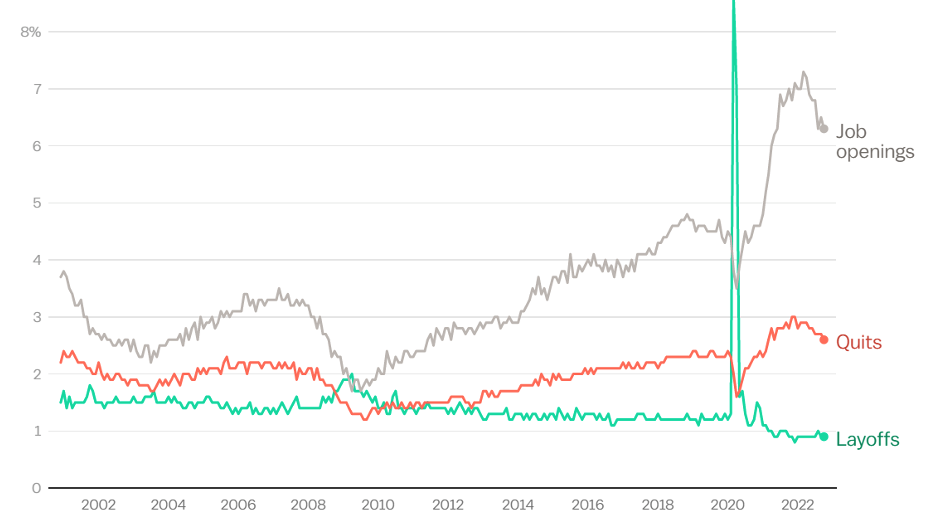What to take away from the logistics industry this December

Remote work here to stay
The effects of the pandemic are slowly disappearing. As of November 2022, hotel occupancy, sports attendance, restaurant dining, and air travel are all nearly the same as 2019 pre-pandemic levels. However, office occupancy is still less than half of what it was pre-pandemic. Remote work showed workers and management that formal office space is not necessary.
Only time will tell. But remote work appears to be a permanent feature of the employment landscape.
Job quits remain elevated due to the favorable job market
Though many businesses are returning to pre-pandemic levels, the Great Resignation continues. This past year produced an unusually high rate of job quits and job openings, but a low number of job layoffs. A large part of the high rate of job quitting is a tight job market. Workers are exploiting a sellers’ market and quitting to take new, more lucrative jobs.

Falling demand eases pressure on global supply chains
Pressure on supply chains eased up substantially this year. This is due, in part, to slowing demand, which produced many of the supply chain headaches in 2021. The Federal Reserve Bank of New York’s Global Supply Chain Pressure Index (featured below) did tick back up slightly in October and November – due to slower delivery times in China (likely caused by persistent, widespread, COVID lockdowns).
Trade from China to the U.S. slows significantly
After reaching record levels during the pandemic lockdowns, vessel TEU (20-ft equivalent unit) volume from China to the United States has dropped significantly since the end of summer 2022. Falling demand, as noted in the previous graph, is largely responsible. U.S. manufacturing orders in China are down 40% and analysts expect additional erosion in the months ahead.
The logistics industry slowing down after pandemic records
The Logistics Managers Index (LMI) continues to slide as economic activity slows for the second month in November. This extends the slow and steady decline from pandemic record highs in mid-2020. The LMI measures economic activity in the logistics industry by surveying logistic managers monthly. A reading greater than 50 suggests growth, and a reading below 50 indicates shrinkage. The LMI produced a record low in April 2020 but then increased considerably as pandemic-induced consumer demand soared.
Container ship lines disappearing
With consumer demand dropping, the daily lines of container ships waiting off at LA and Long Beach ports are disappearing. There is perhaps a no better example of demand contraction than the number of container ships waiting for a berth on the West Coast.
Slowing down inflation
Given the economic slowdowns noted above, it is not surprising that inflation declined in November to 7.1% YOY. The Fed’s aggressive rate increases appear to be working. Prices are declining, demand is falling, and supply chain pressures are easing.
Valentine's Day is a holiday filled with love, flowers, and lots of chocolate. Let's take a look at this graphic showing just how much goes into Cupid's Birthday every single year.
The blockchain isn’t just that weirdly-named coin that your uncle raved about at the Thanksgiving dinner table.
In a world where being eco-conscious is more important than ever, the transportation game is stepping up its green game.
What are the future trends in logistics? Let's chat about what's cooking in the world of transportation.
Let's face it, the world can be a pretty wild place. Every now and then, global events come along that significantly throw us off-balance - especially in the way everything gets made and shipped.
So, you're in the logistics game, and you know that keeping your customers happy is an absolute must. But how do you figure out if you're actually succeeding at customer service?
Navigating the logistics world can sometimes feel like a unique challenge... but trust me, you've got the skills and determination to make some waves in this industry.
In the hustle and bustle of the logistics world, we all know how vital it is to get things right - and hopefully, the first time. Whether it be getting that package to your doorstep on time or making sure goods reach stores and factories without a hitch. But here’s the real question: how do we keep the tech advancements and good ol’ human touch in perfect harmony in this ever-changing industry?
Whether you're new to the industry or want to step up your game, let’s map out your journey to becoming a first-rate logistics leader while on the move.
Navigating the Current: Inflated Fuel, Wage Woes, and Biden's Approval Slides in the Era of Love in Cyberspace, Fueling Relief, and Charging Ahead with Car Costs and Senior Surge, All Against the Backdrop of Inflated Timelines and Charged Distances.
In the world of logistics, where every second counts and every mile matters, technology is rewriting the rules of the game.
Transportation executives, industry observers, and local politicians nodded approvingly and wholeheartedly welcomed the federal largess. After all, the Bipartisan Infrastructure Bill was a once-in-a-generation investment in the country’s logistics infrastructure. The legislation was long overdue and could help reset the supply-chain mess that caused so much havoc during the pandemic.
Explore the dynamic landscape of today's economy with a visual journey through key trends and data points. From plummeting gasoline prices to intriguing shifts in job openings and consumer sentiment, our collection of graphs and visuals offers an engaging perspective on the economic forces at play.
Explore the latest updates on politics, economics, demographics, and more in our informative blog post. Discover insights into crucial topics such as election dynamics, financial trends, population changes, and public opinion. Stay informed with our in-depth analysis of the issues shaping our world today.
Let’s dive deep into various aspects of the current economic landscape, supported by informative graphs and visuals. From auto owners' struggles with loan payments to the dramatic shifts in global container freight rates, we provide a visual overview of key trends affecting our economy.
Explore Key Trends: Job Declines, Imports Surge, Housing Challenges, Sports Trends, and More in Our Latest Post. Stay Informed!
In the run-up to party nominations, the media delves into horserace analyses, fixated on determining who's leading and who's lagging in the campaign landscape. Trump basks in a substantial lead among Republican contenders, while Biden stands uncontested among Democrats.
Explore the South Coast Air Quality Management District's (AQMD) groundbreaking Indirect Source Rule (ISR) mandate, targeting air quality concerns in Southern California's warehouses. Discover the multifaceted impact on the supply chain industry, as we delve into the advantages and drawbacks of the AQMD ISR mandate.
In our latest blog post, we've compiled a series of informative graphs and visuals that shed light on some crucial economic and societal trends. Let's take a glimpse at some of the key highlights.
In recent years, the push for sustainability and carbon footprint reduction in the transportation industry has intensified. A noteworthy development in this pursuit is the shift from conventional diesel-powered Class 8 trucks to electric power. Advocates of this transition tout its potential for a cleaner environment, reduced operating costs, and heightened energy efficiency. Yet, it is imperative to scrutinize the associated challenges and potential pitfalls.
We're diving deep into a dynamic landscape of economic trends and public sentiments: EV Adoption, Driver Behavior, National Debt, & more.
As inflation continues to make headlines, the impact on public perception and policy remains a critical concern. In this analysis, we delve into the intricacies of inflation reporting, exploring how the Consumer Price Index (CPI) serves as a key metric.
This post delves into various important topics, from nearshoring in supply chains to the 2024 election and economic indicators. Discover the latest insights and trends shaping our world.
Check some of the latest graphics around the web: A series of charts, diagrams, and visual representations showcasing billionaire rankings, transportation employment statistics, mineral demand for EVs, and credit card debt trends.
Let’s delve into the latest U.S. trends: Inflation, Emissions, Consumer Habits, and Hollywood’s Comeback.
In the world of ESG investing, the focus has long been on divesting from brown firms and embracing green ones. However, this conventional approach may not be the most effective way to combat climate change and promote sustainability.
From an in-depth analysis of falling Asian exports to the notable rise in cargo volumes at the Port of Los Angeles to the growing demand for used Teslas. Gain valuable insights into these market shifts and their implications in these comprehensive graphs.
Discover the rising representation of women in the supply chain workforce, top private employers in each state, wealth migration patterns, public confidence levels, energy preferences, air travel recovery, economic growth comparisons, and the latest updates on the job market.
From the impact of the pandemic to the (nearly amusing) rivalry between tech giants… let’s explore the latest trends and developments shaping our world.




































Manifest 2024 served as a reminder of the immense potential that lies ahead in the realm of supply chain technology.